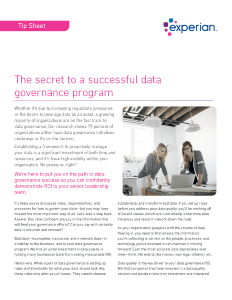- Products

Enjoy a free 30-day trial of our
data validation software.Experience the power of trusted data
solutions today, no credit card required! - Solutions

Enjoy a free 30-day trial of our
data validation software.Experience the power of trusted data
solutions today, no credit card required! - Partners

Enjoy a free 30-day trial of our
data validation software.Experience the power of trusted data
solutions today, no credit card required! - Learn more
- Pricing
- Contact Us
The secret to a successful data governance program
Whether it’s due to increasing regulatory pressures or the desire to leverage data as an asset, a growing majority of organizations are on the fast track to data governance. Our research shows 79 percent of organizations either have data governance initiatives underway or it’s on the horizon. Establishing a framework to proactively manage your data is a significant investment of both time and resources, and it’ll have high visibility within your organization. No pressure, right?
We’re here to put you on the path to data governance success so you can confidently demonstrate ROI to your senior leadership team.
It’s likely you’ve discussed roles, responsibilities, and processes for how to govern your data—but you may have missed the most important step of all. Let’s take a step back. Answer this: How confident are you in the information that will feed your governance efforts? Can you say with certainty data is accurate and relevant? Bad data—incomplete, inaccurate, and irrelevant data—is a liability to the business, and to your data governance program.
We find an underinvestment in data quality is holding many businesses back from seeing measurable ROI. Here’s why. While a part of data governance is setting up rules and thresholds for what your data should look like, those rules only alert you of issues. They cannot cleanse, standardize, and transform bad data. If you set up rules before you address poor data quality, you'll be working off of invalid values, which will undoubtedly undermine data initiatives and result in rework down the road.
As your organization grapples with the volume of data flowing in, you need to first ensure the information you’re collecting is correct so the people, processes, and technology you’ve invested in can maintain it moving forward. Even the most accurate data depreciates over time—think: life events like moves, marriage, children, etc. Data quality is the key driver to your data governance ROI. We find companies that have invested in a data quality solution see positive return on investment and improved data security and compliance.
Your first step is prioritizing operationalizing data quality. Your data governance program is only as successful as the reliability of your data. Invest in data quality management software to examine, diagnose, and treat your data landscape. The proper tools will transform your data into actionable insights and empower you to profile, cleanse, monitor, and enrich your data. Specifically, look for capabilities such as removing duplicates, standardizing inconsistent formats, and appending missing information.
